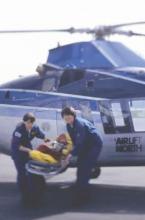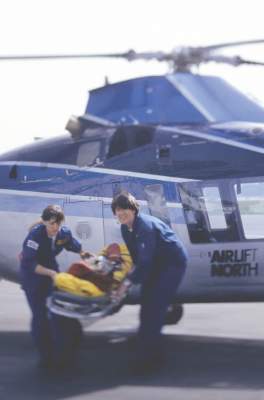User login
SAN ANTONIO – Prehospital blood transfusions during air medical transport did not improve 24-hour or in-hospital mortality at Vanderbilt University Medical Center, Nashville.
Investigators there reviewed 5,581 patients transported by helicopter to Vanderbilt from the scene of injury from the period of 2007-2013; they excluded patients who died on the helipad or in the ED. Average flight time was 48 minutes; 231 patients (4%) received prehospital blood transfusions (PBT) of up to two units of O negative packed red blood cells, which is all that the helicopters carried. The decision to transfuse was up to helicopter personnel who were advised to transfuse hemodynamically unstable patients and those who had lost more than a half liter of blood.
Vanderbilt reviewed its data because although PBT has become widespread in air medical transport, results from military and civilian studies are mixed. “A lot of evidence indicates that early, aggressive resuscitation with blood products improves survival once patients arrive at the hospital. It makes sense that starting the process early would improve outcomes, but relatively little is known about the prehospital environment,” said investigator and general surgery resident Dr. Benjamin Miller.
PBT didn’t seem to help at Vanderbilt. On multivariable regression, in-flight transfusion did not improve 24-hour mortality (OR 1.22; 95% CI 0.61-2.44) or overall in-hospital mortality (OR 1.20; 95% CI 0.55-1.79). It was the same story when 195 transfused patients were matched to 195 who were not transfused, based on mechanism of injury, scene vital signs, injury severity, travel duration, and other measures. Even with matching, PBT did not improve 24-hour mortality (OR 1.04; 95% CI 0.54-1.98) or overall mortality (OR 1.05; 95% CI 0.56-1.96).
There was a trend for improved 24-hour survival with transfusion when injury severity scores were below 20, but it wasn’t statistically significant, perhaps because few of the less injured patients died.
“Our results show no effect of PBT on 24-hour and overall in-hospital mortality. It’s puzzling to us because it’s counterintuitive to the damage control resuscitation strategy,” Dr. Miller said at the annual scientific assembly of the Eastern Association for the Surgery of Trauma.
The findings aren’t robust enough for Vanderbilt to cancel PBT, but they do suggest possible areas for improvement.
Maybe “one or two units of blood are not enough for patients who are severely injured and rapidly exsanguinating, or [maybe] fresh frozen plasma or platelets are needed. Maybe the trigger for transfusion is too low, or too high. It’s time from a prospective study,” Dr. Miller said.
Vanderbilt doesn’t use tranexamic acid to control trauma bleeding. The study didn’t capture volume of crystalloid infused, serum markers of shock, or coagulation study results.
Subjects were in their late 30s, on average, and 70% were men. Transfusions were more likely in younger patients and those with penetrating injuries, poorer at-scene vital signs and Glasgow coma scores, more severe injuries, and lower hematocrits. With the exception of younger age, those factors were also associated with death.
The investigators had no disclosures.
SAN ANTONIO – Prehospital blood transfusions during air medical transport did not improve 24-hour or in-hospital mortality at Vanderbilt University Medical Center, Nashville.
Investigators there reviewed 5,581 patients transported by helicopter to Vanderbilt from the scene of injury from the period of 2007-2013; they excluded patients who died on the helipad or in the ED. Average flight time was 48 minutes; 231 patients (4%) received prehospital blood transfusions (PBT) of up to two units of O negative packed red blood cells, which is all that the helicopters carried. The decision to transfuse was up to helicopter personnel who were advised to transfuse hemodynamically unstable patients and those who had lost more than a half liter of blood.
Vanderbilt reviewed its data because although PBT has become widespread in air medical transport, results from military and civilian studies are mixed. “A lot of evidence indicates that early, aggressive resuscitation with blood products improves survival once patients arrive at the hospital. It makes sense that starting the process early would improve outcomes, but relatively little is known about the prehospital environment,” said investigator and general surgery resident Dr. Benjamin Miller.
PBT didn’t seem to help at Vanderbilt. On multivariable regression, in-flight transfusion did not improve 24-hour mortality (OR 1.22; 95% CI 0.61-2.44) or overall in-hospital mortality (OR 1.20; 95% CI 0.55-1.79). It was the same story when 195 transfused patients were matched to 195 who were not transfused, based on mechanism of injury, scene vital signs, injury severity, travel duration, and other measures. Even with matching, PBT did not improve 24-hour mortality (OR 1.04; 95% CI 0.54-1.98) or overall mortality (OR 1.05; 95% CI 0.56-1.96).
There was a trend for improved 24-hour survival with transfusion when injury severity scores were below 20, but it wasn’t statistically significant, perhaps because few of the less injured patients died.
“Our results show no effect of PBT on 24-hour and overall in-hospital mortality. It’s puzzling to us because it’s counterintuitive to the damage control resuscitation strategy,” Dr. Miller said at the annual scientific assembly of the Eastern Association for the Surgery of Trauma.
The findings aren’t robust enough for Vanderbilt to cancel PBT, but they do suggest possible areas for improvement.
Maybe “one or two units of blood are not enough for patients who are severely injured and rapidly exsanguinating, or [maybe] fresh frozen plasma or platelets are needed. Maybe the trigger for transfusion is too low, or too high. It’s time from a prospective study,” Dr. Miller said.
Vanderbilt doesn’t use tranexamic acid to control trauma bleeding. The study didn’t capture volume of crystalloid infused, serum markers of shock, or coagulation study results.
Subjects were in their late 30s, on average, and 70% were men. Transfusions were more likely in younger patients and those with penetrating injuries, poorer at-scene vital signs and Glasgow coma scores, more severe injuries, and lower hematocrits. With the exception of younger age, those factors were also associated with death.
The investigators had no disclosures.
SAN ANTONIO – Prehospital blood transfusions during air medical transport did not improve 24-hour or in-hospital mortality at Vanderbilt University Medical Center, Nashville.
Investigators there reviewed 5,581 patients transported by helicopter to Vanderbilt from the scene of injury from the period of 2007-2013; they excluded patients who died on the helipad or in the ED. Average flight time was 48 minutes; 231 patients (4%) received prehospital blood transfusions (PBT) of up to two units of O negative packed red blood cells, which is all that the helicopters carried. The decision to transfuse was up to helicopter personnel who were advised to transfuse hemodynamically unstable patients and those who had lost more than a half liter of blood.
Vanderbilt reviewed its data because although PBT has become widespread in air medical transport, results from military and civilian studies are mixed. “A lot of evidence indicates that early, aggressive resuscitation with blood products improves survival once patients arrive at the hospital. It makes sense that starting the process early would improve outcomes, but relatively little is known about the prehospital environment,” said investigator and general surgery resident Dr. Benjamin Miller.
PBT didn’t seem to help at Vanderbilt. On multivariable regression, in-flight transfusion did not improve 24-hour mortality (OR 1.22; 95% CI 0.61-2.44) or overall in-hospital mortality (OR 1.20; 95% CI 0.55-1.79). It was the same story when 195 transfused patients were matched to 195 who were not transfused, based on mechanism of injury, scene vital signs, injury severity, travel duration, and other measures. Even with matching, PBT did not improve 24-hour mortality (OR 1.04; 95% CI 0.54-1.98) or overall mortality (OR 1.05; 95% CI 0.56-1.96).
There was a trend for improved 24-hour survival with transfusion when injury severity scores were below 20, but it wasn’t statistically significant, perhaps because few of the less injured patients died.
“Our results show no effect of PBT on 24-hour and overall in-hospital mortality. It’s puzzling to us because it’s counterintuitive to the damage control resuscitation strategy,” Dr. Miller said at the annual scientific assembly of the Eastern Association for the Surgery of Trauma.
The findings aren’t robust enough for Vanderbilt to cancel PBT, but they do suggest possible areas for improvement.
Maybe “one or two units of blood are not enough for patients who are severely injured and rapidly exsanguinating, or [maybe] fresh frozen plasma or platelets are needed. Maybe the trigger for transfusion is too low, or too high. It’s time from a prospective study,” Dr. Miller said.
Vanderbilt doesn’t use tranexamic acid to control trauma bleeding. The study didn’t capture volume of crystalloid infused, serum markers of shock, or coagulation study results.
Subjects were in their late 30s, on average, and 70% were men. Transfusions were more likely in younger patients and those with penetrating injuries, poorer at-scene vital signs and Glasgow coma scores, more severe injuries, and lower hematocrits. With the exception of younger age, those factors were also associated with death.
The investigators had no disclosures.
AT The EAST SCIENTIFIC ASSEMBLY
Key clinical point: Air transport teams may need to carry more than two units of packed red blood cells.
Major finding: On multivariable regression, in-flight transfusion did not improve 24-hour survival (OR 1.22; 95% CI 0.61-2.44) or overall mortality (OR 1.20; 95% CI 0.55-1.79).
Data source: Retrospective cohort involving 5,581 trauma patients.
Disclosures: The investigators had no disclosures.

